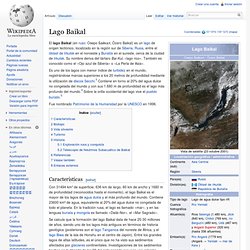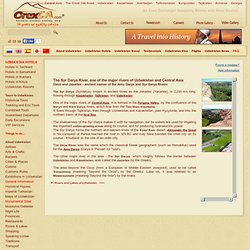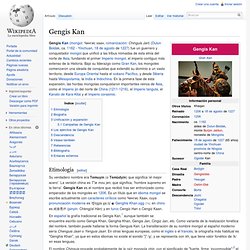

Media-cdn.tripadvisor.com/media/photo-s/01/5b/4b/cb/olkhon-island-roccia. Www.abcteach.com/free/r/rc_geography_lakebaikal_uppermidle.pdf. Espada de genghis khan. Lago Baikal. Svjatoj Nos.

Costa del lago Baikal con vías del tren. Gengis Kan [o Khan] (1167-1227). » MCNBiografias.com. Nombre con el que se conoció al célebre guerrero y conquistador mongol cuyo verdadero nombre era Temudjin, nacido en el año 1167 (en el año 1162 según los anales chinos de la época), en las proximidades del río Onón, en el lago Baikal (actualmente en Rusia), y muerto el 18 de agosto de 1227 ante la ciudad china de Ningxia, en plena campaña por la conquista del Imperio chino.
![Gengis Kan [o Khan] (1167-1227). » MCNBiografias.com](http://cdn.pearltrees.com/s/pic/th/gengis-khan-1167-mcnbiografias-41568426)
Hijo de Yesugei, jefe de la tribu mongol de los kiutes, asentada en el suroeste del lago Baikal, y de la favorita de éste Oelon-Eke ('Madre Nube'), Gengis Kan fue capaz de aglutinar en torno suyo a las numerosas tribus nómadas mongolas que habitaban las estepas del Asia Central y crear uno de los más grandes imperios territoriales registrados a lo largo de la historia, con el que pudo lanzar un impresionante ataque contra el mundo civilizado, en especial contra el Imperio chino, secular enemigo de tártaros y mongoles. Dos años más tarde, en 1229, la gran asamblea mongola nombró a Ogodai Gran Kan mongol.
Bibliografía. 1 in 200 men direct descendants of Genghis Khan. In 2003 a groundbreaking historical genetics paper reported results which indicated that a substantial proportion of men in the world are direct line descendants of Genghis Khan.

By direct line, I mean that they carry Y chromosomes which seem to have come down from an individual who lived approximately 1,000 years ago. As Y chromosomes are only passed from father to son, that would mean that the Y is a record of one’s patrilineage. Genghis Khan died ~750 years ago, so assuming 25 years per generation, you get about 30 men between the present and that period. In more quantitative terms, ~10% of the men who reside within the borders of the Mongol Empire as it was at the death of Genghis Khan may carry his Y chromosome, and so ~0.5% of men in the world, about 16 million individuals alive today, do so. Since 2003 there have been other cases of “super-Y” lineages. You’re probably more familiar with the paraphrase in Conan the Barbarian.
The Genetic Legacy of the Mongols: Invasion of Ghengis Khan in Central Asia. By the beginning of the 13th century, from the tribes of Hi and Tibet, was founded a feudal empire with Ghengis Khan as its ruler.

By that time Ghengis Khan, obsessed by the idea of conquering the world and having united the numerous tribes of Mongols, began his invasion of Central Asia. In his first campaign (up to 1218) Mongolian troops headed by Chingizkhan's elder son Juchi conquered the "forest peoples" living on the banks of the Yenisey River. The Uigurs submitted to Chingizkhan's authority, too. General Khibulai annexed the northern part of the Seven-River Valley. Chingizkhan himself waged a campaign against northern China and occupied Chzhunda (Peking), which was then the capital of the Tzin State. In 1218 Ghengis Khan began a campaign against the Kara-Chinese and Khorezm emperors. After the conquest of Bukhara in April 1220, Ghengis had occupied Samarkand, then Khojend (Khujand) where he made a short pause before the campaign in the direction of the Qarshi steppe and Termez. Syr Darya River, one of the major rivers of Uzbekistan and Central Asia.
The Syr Darya (Syrdarya), known in ancient times as the Jaxartes (Yaxartes), is 2,220 km long, flowing through Kazakhstan, Tajikistan, and Uzbekistan.

One of the major rivers of Central Asia, it is formed in the Fergana Valley, by the confluence of the Naryn and Kara Darya rivers, which flow from the Tian Shan mountains. It flows through Tajikistan, then through Uzbekistan and Kazakhstan, past Kyzylorda, and into the northern basin of the Aral Sea. The shallowness of the Syr Darya makes it unfit for navigation, but its waters are used for irrigating the important cotton-growing areas along its course, and for producing hydroelectric power. The Syr Darya forms the northern and eastern limits of the Kyzyl Kum desert. History, monuments and pictures of Bukhara Uzbekistan. Weather in Bukhara. Bukhara picture. Virtual Tour to Bukhara >>>Hotels in Bukhara >>>Restaurants in Bukhara >>>Historical and architectural monuments of Bukhara >>>Bukhara weather >>> Geographical coordinates: 39°46'29"N 64°25'43"EArea: 39,4 sq.km Population: 270,600 (2005) Time zone: UTC+5 Telephone code: 8 365 Automobile codes: 80-84 Bukhara is an ancient settlement with a history that goes back to the early centuries A.D.

In the 6th century it became the capital of the early feudal lands of the Bukhara oasis. As the Shakhristan, the centre of a shah's realm, it was formed around an ancient citadel, but with the development of handicrafts and trade, new suburbs (rabads) arose beyond its walls, which were included with the Shakhristan in a new fortified wall. Remains of it dating back to the sixteenth century have survived to our day. Gengis Kan. Etimología[editar] Su verdadero nombre era Temuyín (o Temüdyin) que significa 'el mejor acero'.

Genghis Khan: Conquistas de Genghis Khan. Creación del Imperio Mongol.Sucesores de Genhis Khan. El Imperio Mongol, es el de mayor extensión de tierra contigua de la Historia.

Un imperio 2 veces más grande que el de Alejandro Magno y 4 veces más grande que el Imperio Romano. Genghis Khan Biography. Genghis Khan.

The name echoes through the history of Europe and Asia with a drumbeat of horse-hooves, accompanied by the screams of doomed townspeople. Incredibly, in a span of just 25 years, Genghis Khan's horsemen conquered a larger area and greater population than the Romans did in four centuries. To the millions of people his hordes conquered, Genghis Khan was evil incarnate. In Mongolia and across Central Asia today, though, the Great Khan's name is revered. Some Central Asians still name their sons "Chinguz," in hopes that these namesakes will grow up to conquer the world, as their thirteenth century hero did. Genghis Khan's Early Life: Records of the Great Khan's early life are sparse and contradictory.
We know that the boy was given the name Temujin. Yesukhei had kidnapped Temujin's young mother, Hoelun, as she and her first husband rode home from their wedding. Hardship and Captivity: Espada de Genghis Khan. Genghis Khan nació cerca del lago Baikal (en la actual Rusia), en 1167.

Su verdadero nombre era Temojin. Genghis Khan and the Great Mongol Empire. Home | 6th-15th centuries GENGHIS KHAN and the GREAT MONGOL EMPIRE (1 of 4) Genghis Khan | to the Gates of Vienna | from Ogedei to Mongke the Reformer | Kublai Khan in China and to Japan The knights at their tournaments, in their finery, armor and emblems of ancestry, believed they were the foremost warriors in the world, while Mongol warriors thought otherwise.
Mongol horses were small, but their riders were lightly clad and they moved with greater speed. These were hardy men who grew up on horses and hunting, making them better warriors than those who grew up in agricultural societies and cities. The Mongols were illiterate, religiously shamanistic and perhaps no more than 700,000 in number. Mongolia. Genghis Khan Biography. Mongolian warrior and ruler Genghis Khan created the largest empire in the world, the Mongol Empire, by destroying individual tribes in Northeast Asia. Synopsis Genghis Khan was born "Temujin" in Mongolia around 1162. He married at age 16, but had many wives during his lifetime.
At 20, he began building a large army with the intent to destroy individual tribes in Northeast Asia and unite them under his rule. Genghis Khan. Photograph by James L. Stanfield This article was originally published in the December 1996 issue of the magazine. In the northwest wall of old Samarkand stood a gate through which caravans embarked on the Silk Road. La estrategia de guerra de Gengis Khan. Gengis Kan o como también se llamaba originalmente Temüjin nació en una familia de la aristocracia de la sociedad feudal de esa época.
El clan al cual pertenecía era el Borjigin y su padre fue Yesugei-Baghatur y su abuelo por otra parte era Qabul Kan. Cuando muere su padre envenenado por parte de los tártaros les es retirado a él y su familia el apoyo de otros clanes y son obligados a pasar por una situación de indigencia y de hostigamiento por parte de los clanes rivales con quienes había disputa por el janato que había quedado vacante tras la muerte de Yesugei. ¿Por qué el lago Baikal es tan importante para la ciencia? Estamos ante un lugar tan asombroso que podemos visitarlo de dos maneras: como simples turistas, con lo cual ya se nos caerá la baba. O como científicos: entonces descubriremos que este gigantesco lago también tiene mucho que ofrecer. En cualquier caso, si nunca habéis estado en el lago Baikal, situado al sur de la Siberia rusa, voy a intentar transportaros hasta allí lo mejor que pueda.
Coged aire. El Baikal es un lago tan grande (31.494 kilómetros cuadrados de superficie: 650 kilómetros de largo y entre 29 y 80 de ancho) y tan profundo (1.637 metros, aunque si se extrajera todos los sedimentos llegaría a los 9 kilómetros) que contiene el 20 por ciento de las aguas continentales no heladas, esto es, simplificando, del agua dulce del planeta.